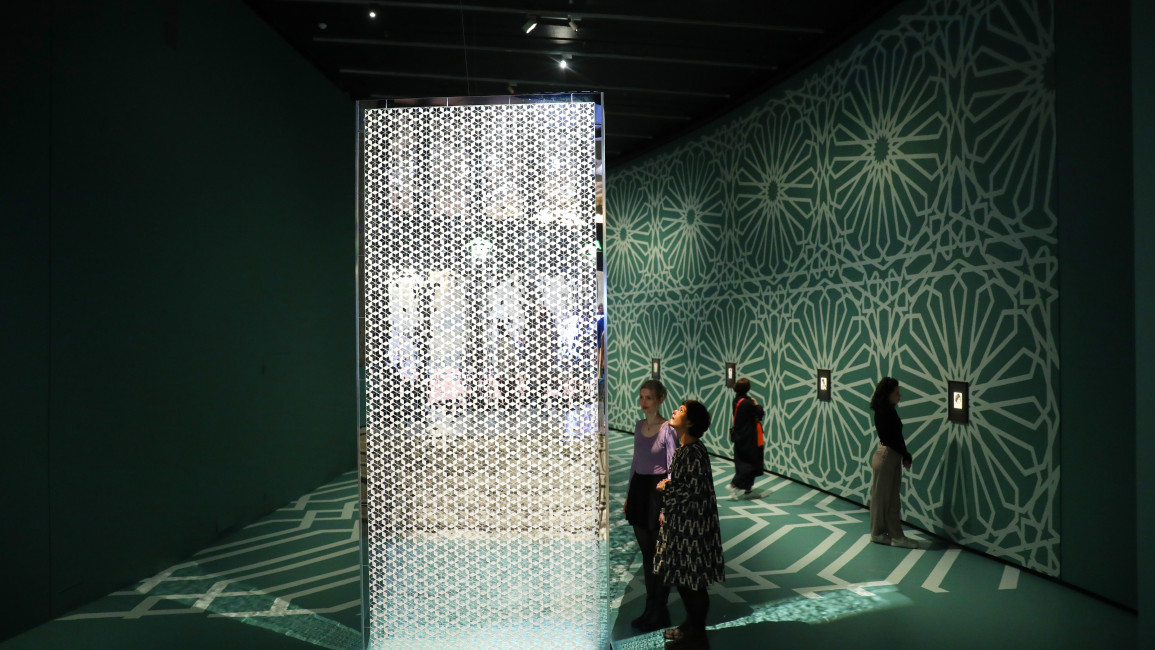
Rebel, Rebel: An ode to Iranian women's spirit of resistance across generations
Soheila Sokhanvari’s exhibition ‘Rebel, Rebel’ showing at the Barbican’s Curve Gallery from 7th October 2022 - 26th February 2023 could not have been more pertinently timed. The exhibition’s theme of iconic Iranian female artists who were outlawed or forced into exile after the Iranian Revolution (1978-79), gives important context to what is unravelling in Iran at the moment, which has been described as a Feminist Revolution.
However, the uprisings in Iran that have gripped the world’s attention for the past weeks has preoccupied Sokhanvari and millions of other Iranian women for much of the past 43 years. Sokhanvari is part of what came to be known as the “Burnt Generation” – those who were either very young at the time of the Revolution or were born after it – and left Iran in 1978, coming to the UK for her secondary and higher education and subsequently settled in this country.
Her memories of Iran were therefore predominantly those of the pre-Revolutionary years of the Pahlavi regime (1925-1979), which were crucial for the emergence of women into the public realm, largely facilitated by the banning of the veil and gendered segregation, getting the right to vote (1963), getting access to education and public office, and the various protections afforded them under the new Family Protection Law of 1967, which allowed them to break free from many of the legal and religious constraints they had lived under during the previous Qajar regime.
"[Sokhanvari] focuses primarily on images of women because she associates these with her memory of Iran and her personal identity, making history and memory pivotal to this exhibition as dominant factors in the construction of identity"
As a result, many women look back on the Pahlavi era with nostalgia for a time when women had rights and freedoms, and as an alternative reference for identity. This is particularly the case with Iranians who were born and grew up before the Revolution and have certain childhood memories from that time.
Sokhanvari recounts that, for her, Iran froze in time at the moment of the Revolution, in a similar manner as Dublin froze in time for James Joyce in 1904 on the occasion of his exile. Thus, she focuses primarily on images of women because she associates these with her memory of Iran and her personal identity, making history and memory pivotal to this exhibition as dominant factors in the construction of identity since they lie at the heart of our sense of self.
This is especially cogent in cases when identity comes under threat, such as in the aftermath of the Iranian Revolution, where the act of remembrance of both collective and personal histories became critical, particularly for the large number of Iranians who left the country.
The recollection and conservation of personal histories and identities in a diaspora which is alien and often hostile allowed Iranians to not only safekeep their histories, but also construct an identity which was separate from those found on social media and news outlets, which designates Iranians with a “terrorist” Islamic identity, “demonic other” and its women as “oppressed” and “backwards”.
Sokhanvari is, consequently, vested in presenting an alternative image to the veiled Iranian women in the contemporary art world, as well as compensating for the lack of Iranian women's (true) image in the media since the Revolution.
Sokhanvari gives us a whole experience, transforming the winding space of the gallery into a Feminist temple with hand-painted murals in an Islamic pattern, similar to the ones found in her paintings. The entrance is marked with a glittering monolith set with 27,000 tessellated pieces of glass, which Sokhanvari has herself painstakingly applied – a work reminiscent of the work of pre-Revolutionary artist, Monir Shahroudy Farmanfarmaian.
|
The Love Addict (Googoosh), 2019 |
Rhapsody of Innocence (Monir Vakili), 2022 |
A Dream Deferred (Haydeh Changizian), 2022 |
© SOHEILA SOKHANVARI. COURTESY OF THE ARTIST AND KRISTIN HJELLEGJERDE GALLERY
In the background, a soundtrack composed by Marios Aristopoulos featuring Sokhanvari’s favourite songs from the period, performed by women artists represented in the portraits, draws us into a bygone era. 28 of these women are depicted in Sokhanvari’s signature miniature style using egg tempera, a technique she learnt from her father, on calf vellum which is symbolic of the sacrificial animal in the Abrahamic religions, and which she also links to the Iranian ideological concept of martyrdom, thereby “creating a notional palimpsest of the stories of the many exiled Iranians like herself”.
Sokhanvari draws her subjects from old grainy, often black-and-white, photographs that she finds on the internet and retains the black-and-white bodies of the original images, but surrounds them with beautiful, almost psychedelic patterns, landscapes and colours inspired by everything from Islamic to art nouveau patterns, drawing the viewers into her world of magic realism.
They remind us of the Proustian idea that remembrance of things past is not necessarily the remembrance of things as they were. Here, imagination interjects to make the past more colourful as though it is viewed through a technicolour nostalgic lens.
"Despite these changes and differences, the Iranian women of yesterday and those of today have the same indomitable spirit, the same zest for life and the same refusal to be dictated to by a patriarchal state"
The small size of the portraits is in sharp contrast to the tall ceiling of the gallery, beckoning us to get closer to these women and engage with them on a more personal level. There are no labels – just a number assigned to each image - so you must put your pre-judgements aside and see these women, first and foremost, as human beings.
The women depicted all have special importance for Iranian feminism and for Sokhanvari, who one feels is searching for herself in each and every one of them. It starting with Roohangiz Saminejad, the first Iranian actor to appear in a talkie movie, who subsequently received death threats for her unveiled appearance in the movie and suffered social ostracism and sexual harassment from men to the point that she had to change her name and live in anonymity and seclusion.
The exhibit ends with Nosrat Partovi, the last unveiled woman to appear in Filmfarsi, whose only movie, The Deer, was screened in Abadan’s Cinema Rex when Islamic revolutionaries locked the doors and set fire to the building, killing hundreds and helping to spark the revolution.
Likewise depicted are artists from popular entertainment such as Googoosh, Sokhanvari’s favourite singer who was unable to perform for 21 years until she left Iran to resume her singing career, as well as opera star Monir Vakili and ballet star Haydeh Changizian – all which have been banned in the Islamic Republic.
Another female icon represented, is the late feminist poet Forough Farrokhzad, whose continuing popularity with young Iranian women, 55 years after her death, is a sore point with the Islamic Republic who tried, unsuccessfully, to ban her writing.
Rebel, Rebel therefore reminds us that there is a stark difference in the pre- and post- Revolutionary Iranian women as far as outward appearance, personal freedoms and rights are concerned. However, it also reminds us that despite these changes and differences, the Iranian women of yesterday and those of today have the same indomitable spirit, the same zest for life and the same refusal to be dictated to by a patriarchal state.
It is these “rebels”, inspired by their rebellious predecessors, who are the hope for a new Iran!
Katy Shahandeh is a final year PhD candidate at SOAS, a research and teaching assistant. Her academic interests are Middle Eastern (with an emphasis on Iran) art, history, culture and society, and her research, based on the works of contemporary Iranian women artists, is located around issues of gender, identity and society, and informed by feminist and post-colonial theory. She has contributed to a volume published by Routledge entitled Curating as Feminist Organizing (2022).
Join the conversation @The_NewArab.
Have questions or comments? Email us at: editorial-english@newarab.com
Opinions expressed in this article remain those of the author and do not necessarily represent those of The New Arab, its editorial board or staff.







